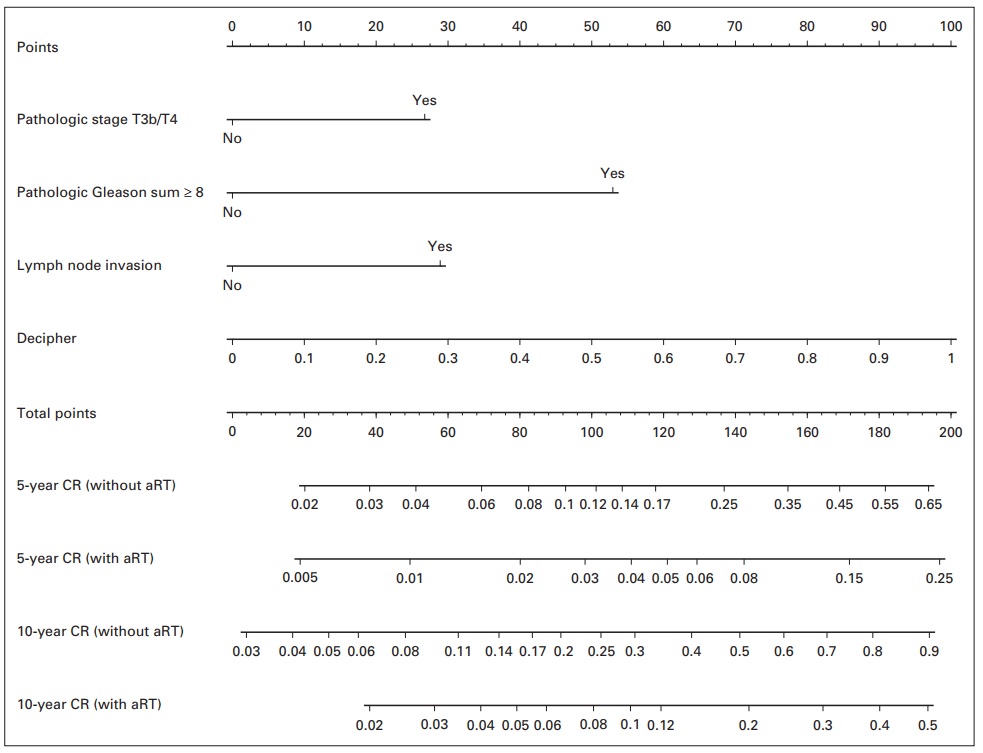(구)글로벌 핫이슈
방사선종양학
- [J Clin Oncol.] Genomic Classifier Augments the Role of Pathological Features in Identifying Optimal Candidates for Adjuvant Radiation Therapy in Patients With Prostate Cancer: Development and Internal Validation of a Multivariable Prognostic Model
Henry Ford Health System / Firas Abdollah*
- 출처
- J Clin Oncol.
- 등재일
- 2017 Jun 20
- 저널이슈번호
- 35(18):1982-1990. doi: 10.1200/JCO.2016.69.9918. Epub 2017 Mar 28.
- 내용
Abstract
Purpose
Despite documented oncologic benefit, use of postoperative adjuvant radiotherapy (aRT) in patients with prostate cancer is still limited in the United States. We aimed to develop and internally validate a risk-stratification tool incorporating the Decipher score, along with routinely available clinicopathologic features, to identify patients who would benefit the most from aRT.
Patient and Methods
Our cohort included 512 patients with prostate cancer treated with radical prostatectomy at one of four US academic centers between 1990 and 2010. All patients had ≥ pT3a disease, positive surgical margins, and/or pathologic lymph node invasion. Multivariable Cox regression analysis tested the relationship between available predictors (including Decipher score) and clinical recurrence (CR), which were then used to develop a novel risk-stratification tool. Our study adhered to the Transparent Reporting of a Multivariable Prediction Model for Individual Prognosis or Diagnosis guidelines for development of prognostic models.
Results
Overall, 21.9% of patients received aRT. Median follow-up in censored patients was 8.3 years. The 10-year CR rate was 4.9% vs. 17.4% in patients treated with aRT versus initial observation ( P < .001). Pathologic T3b/T4 stage, Gleason score 8-10, lymph node invasion, and Decipher score > 0.6 were independent predictors of CR (all P < .01). The cumulative number of risk factors was 0, 1, 2, and 3 to 4 in 46.5%, 28.9%, 17.2%, and 7.4% of patients, respectively. aRT was associated with decreased CR rate in patients with two or more risk factors (10-year CR rate 10.1% in aRT v 42.1% in initial observation; P = .012), but not in those with fewer than two risk factors ( P = .18).
Conclusion
Using the new model to indicate aRT might reduce overtreatment, decrease unnecessary adverse effects, and reduce risk of CR in the subset of patients (approximately 25% of all patients with aggressive pathologic disease in our cohort) who benefit from this therapy.

Fig 2.
Nomogram predicting the probability of clinical recurrence-free survival (CRFS) in patients with prostate cancer with adverse pathologic features at radical prostatectomy on the basis of pathologic stage, pathologic Gleason score, lymph node invasion, and Decipher score. Nomogram outcomes were stratified based on adjuvant radiotherapy (aRT) status. For example, locate the patient’s Decipher score on the Decipher axis. Draw a line straight up to the point axis to determine how many points toward the probability of CRFS the patient receives for his Decipher score. Repeat the process for each additional variable. Sum the points for each predictor. Locate the final sum on the total-point axis. Draw a line straight down to find the patient’s 5- and 10-year probability of CRFS. CR, clinical recurrence.
Author information
Dalela D1, Santiago-Jiménez M1, Yousefi K1, Karnes RJ1, Ross AE1, Den RB1, Freedland SJ1, Schaeffer EM1, Dicker AP1, Menon M1, Briganti A1, Davicioni E1, Abdollah F1.
1 Deepansh Dalela, Mani Menon, and Firas Abdollah, Henry Ford Health System, Detroit, MI; María Santiago-Jiménez, Kasra Yousefi, and Elai Davicioni, GenomeDx Biosciences, Vancouver, British Columbia, Canada; R. Jeffrey Karnes, Mayo Clinic, Rochester, MN; Ashley E. Ross, Johns Hopkins Hospital, Baltimore, MD; Adam P. Dicker and Robert B. Den, Thomas Jefferson University, Philadelphia, PA; Stephen J. Freedland, Cedars-Sinai Medical Center, Los Angeles, CA; Edward M. Schaeffer, Northwestern University Feinberg School of Medicine, Chicago, IL; and Alberto Briganti, Vita Salute San Raffaele Hospital, Milan, Italy.
- 덧글달기
- 이전글 [Clin Cancer Res.] Integrative Analysis Identifies a Novel AXL-PI3 Kinase-PD-L1 Signaling Axis Associated with Radiation Resistance in Head and Neck Cancer
- 다음글 [ J Clin Oncol.] Hypofractionated Postmastectomy Radiation Therapy Is Safe and Effective: First Results From a Prospective Phase II Trial









